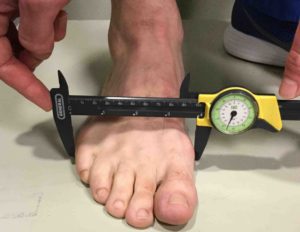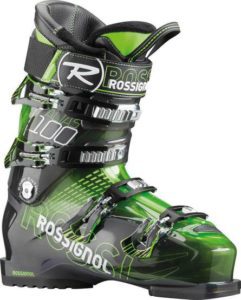Severe Arch Pain and Cramping When Skiing
A common problem I treat in my patients who ski is a condition that causes severe, searing pain in the arches of the feet. This is a problem most commonly found in skiers who have flat feet.
Video: Treating Arch Pain in Skiers
Note: This video does not include the important arch strengthening information found below
What Causes Severe Arch Pain When Skiing?
The pain is due to overuse of the small muscles in the bottom of the foot. These are called the “intrinsic muscles” of the foot and they both start and end within the foot itself (as opposed to the “extrinsic muscles” which are the ones that start in the leg and end in the foot).
A flat foot tends to be a very unstable foot and skiing requires stability to transfer force effectively from the boot to the edge of the ski to turn the ski.
When people with unstable feet ski, the intrinsic muscles start working exceptionally hard to help stabilize the foot. Eventually they just run out of adequate blood flow to support their activity and the searing pain in the arch begins.
Is There a Name for this Condition?
This condition is not well studied or described in the literature. Among those of us who treat it regularly it is referred to as “Skier’s Foot Myalgia” (foot muscle pain) or “plantar intrinsic stress syndrome”. 1
How Can Skiing Arch Pain Be Treated?
Treatment is focused on three main areas:
- Strengthening the intrinsic muscles of the foot
- Supporting the foot with an orthotic made especially for flat feet
- Ensuring proper boot fit. In particular, avoiding boots that are too tight around the foot
Orthotics for Flat Footed Skiers
To transfer force effectively from the boot to the ski the foot must be stabilized inside the boot. While footbeds from a ski shop can work well for most skiers, they usually lack the proper modifications to support a skier with a flat foot.
You can read detailed information on how orthotics should be made for flat feet here, but in general the orthotics must:
- Be made from a non-weight bearing image of the foot
- Conform very close to the arch of the foot
- Curve up around the inside arch of the foot to adequately support the arch (a “medial flange”)
- Incorporate wedging in the heel to stop the heel from rolling in (a “varus wedge”)
Again, you can read much more detailed information on orthotics for flat feet here. Of course, the orthotic must be modified to fit into a ski boot. Learn general information about ski orthotics here.
You are not likely to find this type of orthotic in a ski shop and will most likely find that a podiatrist who specializes in orthotic therapy and sports medicine is most skilled at making these sophisticated orthotics. If possible, find a podiatrist who is experienced with skiers.
Strengthening the Intrinsic Muscles of the Foot
Several studies have shown that people with flat feet have weak intrinsic muscles of the foot. A 2014 study used ultrasound to measure the size of the instrinsic muscles and found that people with flat feet had significantly smaller intrinsic muscles than those with normal arch feet.2
This means those muscles are weaker than they should be and when a skier calls on those muscles to help control a turn they are unable to so and become fatigued very quickly.
Best Exercise to Strengthen the Intrinsic Muscles
A 2011 study evaluated which exercise was the best at strengthening the intrinsic muscles, particularly the “abductor hallucis” which is the most important intrinsic muscle for stabilizing the arch and helping you control your ski.3
Based on this study the recommended method to strengthen the arch muscles is an foot exercise called “doming”. Instructions on how to do this exercise plus two other exercises are found in our Top 5 Tips to Cure Skiers Foot Pain download, which you can get below.
When and How Often to Strengthen the Arch for Skiing
I provide my patients with a schedule to do the recommended ski / snowboard foot strengthening exercises starting at least a month prior to ski season if possible. The exact exercise plan is based on how flat their feet are, the level of their symptoms, other activities in which they participate and how often they plan to ski.
Wearing Orthotics Daily May Help Strengthen the Arch
A 2011 study examined the effects of foot orthoses and an arch muscle exercise program on the size (and thus strength) of the abductor hallucis muscle and strength of the flexor hallucis (one of the extrinsic muscles) in people with flat feet.4
Results from this study demonstrate that foot orthoses combined with short-foot exercise is more effective in increasing the size of the Abductor Hallucis muscle and the strength of Flexor Hallucis compared with foot orthoses alone.
They concluded that foot orthoses combined with short-foot exercise are recommended for improving strength of Abductor Hallucis muscle in subjects with pes planus (flat feet).
So, for skiers trying to eliminate these arch pain symptoms we recommend that they wear orthotics specifically for flat feet essentially every day, not just when they are skiing.
If you are in the Seattle area contact us to be evaluated for custom flat foot orthotics for your ski boots and your daily shoes.
Are Your Boots Wide Enough?
Finally, proper boot fit is critical. Boots that are just a little bit too narrow can make these symptoms worse.
In particular, ensure that your boots are wide enough for your forefoot.
As shown in the figure, we measure the forefoot of our skiing patients and provide them with recommendations on appropriate boots for  their foot type.
their foot type.
How to Get Treatment for Arch Pain in Skiers
If you are in the Seattle area, make an appointment to see us. Be sure to bring your boots with you.
If you are outside of the Seattle region, check out our online course, Ski and Snowboard Without Foot Pain. In this course we provide all of the information we give to patients in our clinic. In fact, because there are no time restrictions you will get more education on eliminating foot pain in skiers and snowboarders.
References: Arch Pain in Skiers
- Personal communication with Kevin Kirby, DPM
- Angin, et al. Ultrasound evaluation of foot muscles and plantar fascia in pes planus. Gait Posture. 2014
- Jung DY, et al. A comparison in the muscle activity of the abductor hallucis and the medial longitudinal arch angle during toe curl and short foot exercises. Phys Ther Sport 2011.
- Jung D, et al. Effect of foot orthoses and short-foot exercise on the cross-sectional area of the abductor hallucis muscle in subjects with pes planus: a randomized controlled trial. J Back Musculoskelet Rehabil. 2011
- Do I Have to Keep Wearing My Orthotics if My Feet Feel Better? - November 29, 2019
- Flip Flops and Sandals for Ball of Foot Pain | Podiatrist Recommended - August 5, 2018
- How To Strengthen the Arch of Foot - August 31, 2017

